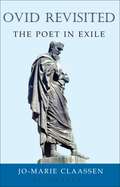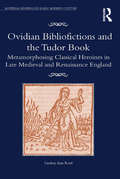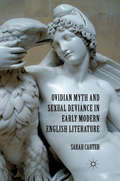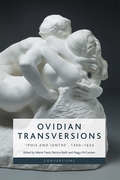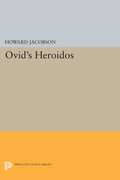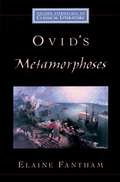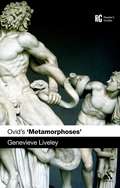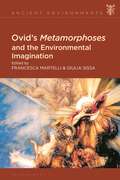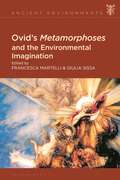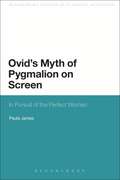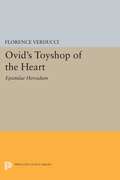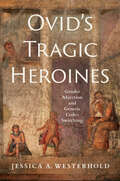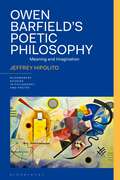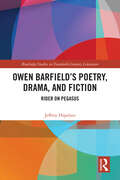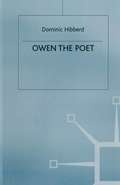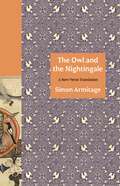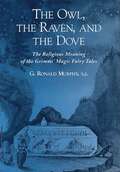- Table View
- List View
Ovid Revisited: The Poet in Exile
by Jo-Marie ClaassenIn time for the bimillennium of Ovid's relegation to Tomis on the Black Sea by the emperor Augustus in 8 AD, Jo-Marie Claassen here revises and integrates into a more popular format two decades of scholarship on Ovid's exile. Some twenty articles and reviews from scholarly journals have been shortened, rearranged and merged into seven chapters, which, together with some new material, offer a wide-ranging overview of the exiled poet and his works. "Ovid Revisited" treats the poems from exile as the literary culmination of Ovid's oeuvre, ascribing the poet's resilience in the face of extreme hardship to the relief that his poetry afforded him. An introduction considers the phenomenon of Ovid's continued popularity, explains the importance of chronology in reading the exilic poems and gives a brief summary of the contents of the 'Tristia' and 'Epistulae ex Ponto'. The rest of the book ranges from consideration of Ovid's relationship with the emperor and with his own poetry, to his ubiquitous humour, to his skill in metrics, vocabulary and verbal play, and to his use of mythological figures from earlier parts of his oeuvre. The degree to which Ovid universalised the sufferings of the dispossessed is assessed in a chapter comparing his exilic works with modern exilic literature. An excursus considers various directions in Ovidian studies today.
Ovidian Bibliofictions and the Tudor Book: Metamorphosing Classical Heroines in Late Medieval and Renaissance England (Material Readings in Early Modern Culture)
by Lindsay Ann ReidOvidian Bibliofictions and the Tudor Book examines the historical and the fictionalized reception of Ovid’s poetry in the literature and books of Tudor England. It does so through the study of a particular set of Ovidian narratives-namely, those concerning the protean heroines of the Heroides and Metamorphoses. In the late medieval and Renaissance eras, Ovid’s poetry stimulated the vernacular imaginations of authors ranging from Geoffrey Chaucer and John Gower to Isabella Whitney, William Shakespeare, and Michael Drayton. Ovid’s English protégés replicated and expanded upon the Roman poet’s distinctive and frequently remarked ’bookishness’ in their own adaptations of his works. Focusing on the postclassical discourses that Ovid’s poetry stimulated, Ovidian Bibliofictions and the Tudor Book engages with vibrant current debates about the book as material object as it explores the Ovidian-inspired mythologies and bibliographical aetiologies that informed the sixteenth-century creation, reproduction, and representation of books. Further, author Lindsay Ann Reid’s discussions of Ovidianism provide alternative models for thinking about the dynamics of reception, adaptation, and imitatio. While there is a sizeable body of published work on Ovid and Chaucer as well as on the ubiquitous Ovidianism of the 1590s, there has been comparatively little scholarship on Ovid’s reception between these two eras. Ovidian Bibliofictions and the Tudor Book begins to fill this gap between the ages of Chaucer and Shakespeare by dedicating attention to the literature of the early Tudor era. In so doing, this book also contributes to current discussions surrounding medieval/Renaissance periodization.
Ovidian Bibliofictions and the Tudor Book: Metamorphosing Classical Heroines in Late Medieval and Renaissance England (Material Readings in Early Modern Culture)
by Lindsay Ann ReidOvidian Bibliofictions and the Tudor Book examines the historical and the fictionalized reception of Ovid’s poetry in the literature and books of Tudor England. It does so through the study of a particular set of Ovidian narratives-namely, those concerning the protean heroines of the Heroides and Metamorphoses. In the late medieval and Renaissance eras, Ovid’s poetry stimulated the vernacular imaginations of authors ranging from Geoffrey Chaucer and John Gower to Isabella Whitney, William Shakespeare, and Michael Drayton. Ovid’s English protégés replicated and expanded upon the Roman poet’s distinctive and frequently remarked ’bookishness’ in their own adaptations of his works. Focusing on the postclassical discourses that Ovid’s poetry stimulated, Ovidian Bibliofictions and the Tudor Book engages with vibrant current debates about the book as material object as it explores the Ovidian-inspired mythologies and bibliographical aetiologies that informed the sixteenth-century creation, reproduction, and representation of books. Further, author Lindsay Ann Reid’s discussions of Ovidianism provide alternative models for thinking about the dynamics of reception, adaptation, and imitatio. While there is a sizeable body of published work on Ovid and Chaucer as well as on the ubiquitous Ovidianism of the 1590s, there has been comparatively little scholarship on Ovid’s reception between these two eras. Ovidian Bibliofictions and the Tudor Book begins to fill this gap between the ages of Chaucer and Shakespeare by dedicating attention to the literature of the early Tudor era. In so doing, this book also contributes to current discussions surrounding medieval/Renaissance periodization.
Ovidian Myth and Sexual Deviance in Early Modern English Literature
by S. CarterCarter explores early modern culture's reception of Ovid through the manipulation of Ovidian myth by Shakespeare, Middleton, Heywood, Marlowe and Marston. With a focus on sexual violence, homosexuality, incest and idolatry, Carter analyses how depictions of mythology represent radical ideas concerning gender and sexuality.
Ovidian Transversions: ‘Iphis and Ianthe’, 1300-1650 (Conversions)
by Valerie Traub Patricia Badir Peggy McCrackenMedieval and early modern authors engaged with Ovid’s tale of ‘Iphis and Ianthe’ in a number of surprising ways. From Christian translations to secular retellings on the seventeenth-century stage, Ovid’s story of a girl’s miraculous transformation into a boy sparked a diversity of responses in English and French from the fourteenth to the seventeenth centuries. In addition to analysing various translations and commentaries, the volume clusters essays around treatments of John Lyly’s Galatea (c. 1585) and Issac de Benserade’s Iphis et Iante (1637). As a whole, the volume addresses gender and transgender, sexuality and gallantry, anatomy and alchemy, fable and history, youth and pedagogy, language and climate change.
Ovidian Transversions: ‘Iphis and Ianthe’, 1300-1650 (Conversions)
Medieval and early modern authors engaged with Ovid’s tale of ‘Iphis and Ianthe’ in a number of surprising ways. From Christian translations to secular retellings on the seventeenth-century stage, Ovid’s story of a girl’s miraculous transformation into a boy sparked a diversity of responses in English and French from the fourteenth to the seventeenth centuries. In addition to analysing various translations and commentaries, the volume clusters essays around treatments of John Lyly’s Galatea (c. 1585) and Issac de Benserade’s Iphis et Iante (1637). As a whole, the volume addresses gender and transgender, sexuality and gallantry, anatomy and alchemy, fable and history, youth and pedagogy, language and climate change.
Ovid's Heroidos
by Howard JacobsonA series of letters purportedly written by Penelope, Dido, Medea, and other heroines to their lovers, the Heroides represents Ovid's initial attempt to revitalize myth as a subject for literature. In this book, Howard Jacobson examines the first fifteen elegaic letters of the Heroides.In his critical evaluation, Professor Jacobson takes into consideration the twofold nature of the work: its existence as a single entity with uniform poetic structure and coherent goals, and its existence as a collection of fifteen individual poems. Thus, fifteen chapters are devoted to a thorough analysis and interpretation of the particular poems, while six additional chapters are concerned with problems that pertain to the work as a whole, such as the nature of the genre, the role of rhetoric, theme, and variation, and the originality of Ovid.Special attention is given to the application of modern psychological criticism to the delineations of the pathological psyche in the letters. In an additional chapter on the chronology of Ovid's early amatory poetry, the author challenges and revises the traditional dating of the Heroides.Originally published in 1974.The Princeton Legacy Library uses the latest print-on-demand technology to again make available previously out-of-print books from the distinguished backlist of Princeton University Press. These editions preserve the original texts of these important books while presenting them in durable paperback and hardcover editions. The goal of the Princeton Legacy Library is to vastly increase access to the rich scholarly heritage found in the thousands of books published by Princeton University Press since its founding in 1905.
Ovid's Metamorphoses (Oxford Approaches to Classical Literature)
by Elaine FanthamOxford Approaches to Classical Literature (Series Editors: Kathleen Coleman and Richard Rutherford) introduces individual works of Greek and Latin literature to readers who are approaching them for the first time. Each volume sets the work in its literary and historical context, and aims to offer a balanced and engaging assessment of its content, artistry, and purpose. A brief survey of the influence of the work upon subsequent generations is included to demonstrate its enduring relevance and power. All quotations from the original are translated into English. Ovid's Metamorphoses have been seen as both the culmination of and a revolution in the classical epic tradition, transferring narrative interest from war to love and fantasy. This introduction considers how Ovid found and shaped his narrative from the creation of the world to his own sophisticated times, illustrating the cruelty of jealous gods, the pathos of human love, and the imaginative fantasy of flight, monsters, magic, and illusion. Elaine Fantham introduces the reader not only to this marvelous and complex narrative poem, but to the Greek and Roman traditions behind Ovid's tales of transformation and a selection of the images and texts that it inspired.
Ovid's 'Metamorphoses': A Reader's Guide (Reader's Guides)
by Genevieve LiveleyPerhaps no other classical text has proved its versatility so much as Ovid's epic poem. A staple of undergraduate courses in Classical Studies, Latin, English and Comparative Literature, Metamorphoses is arguably one of the most important, canonical Latin texts and certainly among the most widely read and studied.Ovid's 'Metamorphoses': A Reader's Guide is the ideal companion to this epic classical text offering guidance on:• Literary, historical and cultural context• Key themes• Reading the text• Reception and influence• Further reading
Ovid's 'Metamorphoses': A Reader's Guide (Reader's Guides)
by Genevieve LiveleyPerhaps no other classical text has proved its versatility so much as Ovid's epic poem. A staple of undergraduate courses in Classical Studies, Latin, English and Comparative Literature, Metamorphoses is arguably one of the most important, canonical Latin texts and certainly among the most widely read and studied.Ovid's 'Metamorphoses': A Reader's Guide is the ideal companion to this epic classical text offering guidance on:• Literary, historical and cultural context• Key themes• Reading the text• Reception and influence• Further reading
Ovid's Metamorphoses and the Environmental Imagination (Ancient Environments)
by Francesca Martelli and Giulia SissaThis book positions Ovid's Metamorphoses as a foundational text in the western history of environmental thought. The poem is about new bodies. Stones, springs, plants and animals materialize out of human origins to create a world of hybrid objects, which retain varying degrees of human subjectivity while taking on new physical form. In bending the boundaries of known categories of being, these hybrid entities reveal both the porousness of human and other agencies as well as the dangers released by their fusion. Metamorphosis unsettles the category of the human within the complex ecologies that make up the world as we know it.Drawing on a range of modern environmental theorists and approaches, the contributors to this volume trace how the Metamorphoses models the relationship between humans and other life forms in ways that resonate with the preoccupations of contemporary eco-criticism. They make the case for seeing the worldview depicted in Ovid's poem as an exemplar of the 'premodern' ecological mindset that contemporary environmental thought seeks to approximate. They also highlight critical moments in the history of the poem's ecological reception, including reflections by a contemporary poet, as well as studies of Medieval and Renaissance responses to Ovid.
Ovid's Metamorphoses and the Environmental Imagination (Ancient Environments)
This book positions Ovid's Metamorphoses as a foundational text in the western history of environmental thought. The poem is about new bodies. Stones, springs, plants and animals materialize out of human origins to create a world of hybrid objects, which retain varying degrees of human subjectivity while taking on new physical form. In bending the boundaries of known categories of being, these hybrid entities reveal both the porousness of human and other agencies as well as the dangers released by their fusion. Metamorphosis unsettles the category of the human within the complex ecologies that make up the world as we know it.Drawing on a range of modern environmental theorists and approaches, the contributors to this volume trace how the Metamorphoses models the relationship between humans and other life forms in ways that resonate with the preoccupations of contemporary eco-criticism. They make the case for seeing the worldview depicted in Ovid's poem as an exemplar of the 'premodern' ecological mindset that contemporary environmental thought seeks to approximate. They also highlight critical moments in the history of the poem's ecological reception, including reflections by a contemporary poet, as well as studies of Medieval and Renaissance responses to Ovid.
Ovid's Myth of Pygmalion on Screen: In Pursuit of the Perfect Woman (Continuum Studies in Classical Reception)
by Paula JamesWhy has the myth of Pygmalion and his ivory statue proved so inspirational for writers, artists, philosophers, scientists, and directors and creators of films and television series? The 'authorised' version of the story appears in the epic poem of transformations, Metamorphoses, by the first-century CE Latin poet Ovid; in which the bard Orpheus narrates the legend of the sculptor king of Cyprus whose beautiful carved woman was brought to life by the goddess Venus.Focusing on screen storylines with a Pygmalion subtext, from silent cinema to Buffy the Vampire Slayer and Lars and the Real Girl, this book looks at why and how the made-over or manufactured woman has survived through the centuries and what we can learn about this problematic model of 'perfection' from the perspective of the past and the present. Given the myriad representations of Ovid's myth, can we really make a modern text a tool of interpretation for an ancient poem? This book answers with a resounding 'yes' and explains why it is so important to give antiquity back its future.
Ovid's Myth of Pygmalion on Screen: In Pursuit of the Perfect Woman (Continuum Studies in Classical Reception #5)
by Paula JamesWhy has the myth of Pygmalion and his ivory statue proved so inspirational for writers, artists, philosophers, scientists, and directors and creators of films and television series? The 'authorised' version of the story appears in the epic poem of transformations, Metamorphoses, by the first-century CE Latin poet Ovid; in which the bard Orpheus narrates the legend of the sculptor king of Cyprus whose beautiful carved woman was brought to life by the goddess Venus.Focusing on screen storylines with a Pygmalion subtext, from silent cinema to Buffy the Vampire Slayer and Lars and the Real Girl, this book looks at why and how the made-over or manufactured woman has survived through the centuries and what we can learn about this problematic model of 'perfection' from the perspective of the past and the present. Given the myriad representations of Ovid's myth, can we really make a modern text a tool of interpretation for an ancient poem? This book answers with a resounding 'yes' and explains why it is so important to give antiquity back its future.
Ovid's Toyshop of the Heart: "Epistulae Heroidum"
by Florence VerducciFlorence Verducci challenges the presuppositions and expectations that have led to embarrassed censure of the wit and comic irreverence that Ovid wove into these dramatic monologues, addressed by his heroines to absent lovers.Originally published in 1986.The Princeton Legacy Library uses the latest print-on-demand technology to again make available previously out-of-print books from the distinguished backlist of Princeton University Press. These editions preserve the original texts of these important books while presenting them in durable paperback and hardcover editions. The goal of the Princeton Legacy Library is to vastly increase access to the rich scholarly heritage found in the thousands of books published by Princeton University Press since its founding in 1905.
Ovid's Tragic Heroines: Gender Abjection and Generic Code-Switching
by Jessica A. WesterholdOvid's Tragic Heroines expands our understanding of Ovid's incorporation of Greek generic codes and the tragic heroines, Phaedra and Medea, while offering a new perspective on the Roman poet's persistent interest in these two characters and their paradigms. Ovid presents these two Attic tragic heroines as symbols of different passions that are defined by the specific combination of their gender and generic provenance. Their failure to be understood and their subsequent punishment are constructed as the result of their female "nature," and are generically marked as "tragic." Ovid's masculine poetic voice, by contrast, is given free rein to oscillate and play with poetic possibilities. Jessica A. Westerhold focuses on select passages from the poems Ars Amatoria, Heroides, and Metamorphoses. Building on existing scholarship, she analyzes the dynamic nature of generic categories and codes in Ovid's poetry, especially the interplay of elegy and epic. Further, her analysis of Ovid's reception applies the idea of the abject to elucidate Ovid's process of constructing gender and genre in his poetry. Ovid's Tragic Heroines incorporates established theories of the performativity of sex, gender, and kinship roles to understand the continued maintenance of the normative and abject subject positions Ovid's poetry creates. The resulting analysis reveals how Ovid's Phaedras and Medeas offer alternatives both to traditional gender roles and to material appropriate to a poem's genre, ultimately using the tragic code to introduce a new perspective to epic and elegy.
Owen Barfield’s Poetic Philosophy: Meaning and Imagination (Bloomsbury Studies in Philosophy and Poetry)
by Dr Jeffrey HipolitoThe first book to offer an overview, at once introductory and comprehensive, of the philosophical thought of Owen Barfield, sometimes known as the “first and last Inkling” and as the “British Heidegger.”Beginning by placing Barfield's early poetics in the context of the critical hurly-burly of modernist London of the 1920s, Owen Barfield's Poetic Philosophy: Meaning and Imagination shows how Barfield's subsequent development of a philosophy of history, metaphysics, and ethics culminates in his development of a poetic cosmology. Hipolito situates Barfield's poetic philosophy in relation to his significant contemporaries (and predecessors) including T.S. Eliot, D.H. Lawrence, I.A. Richards, Jean Paul Sartre, Martin Heidegger and Ernst Cassirer, bringing to light for the first time many important aspects of Barfield's thought. The book concludes with an analysis of the Burgeon trilogy, in which Barfield recapitulates the themes and arguments of his poetic philosophy by exemplifying them in three genre-defying works of fiction.Structured chronologically and giving a systematic examination of Barfield's thought, Owen Barfield's Poetic Philosophy paints a much-needed picture of a major thinker and poet, who was entirely engaged with his times and who remains crucially relevant to our own.
Owen Barfield’s Poetic Philosophy: Meaning and Imagination (Bloomsbury Studies in Philosophy and Poetry)
by Dr Jeffrey HipolitoThe first book to offer an overview, at once introductory and comprehensive, of the philosophical thought of Owen Barfield, sometimes known as the “first and last Inkling” and as the “British Heidegger.”Beginning by placing Barfield's early poetics in the context of the critical hurly-burly of modernist London of the 1920s, Owen Barfield's Poetic Philosophy: Meaning and Imagination shows how Barfield's subsequent development of a philosophy of history, metaphysics, and ethics culminates in his development of a poetic cosmology. Hipolito situates Barfield's poetic philosophy in relation to his significant contemporaries (and predecessors) including T.S. Eliot, D.H. Lawrence, I.A. Richards, Jean Paul Sartre, Martin Heidegger and Ernst Cassirer, bringing to light for the first time many important aspects of Barfield's thought. The book concludes with an analysis of the Burgeon trilogy, in which Barfield recapitulates the themes and arguments of his poetic philosophy by exemplifying them in three genre-defying works of fiction.Structured chronologically and giving a systematic examination of Barfield's thought, Owen Barfield's Poetic Philosophy paints a much-needed picture of a major thinker and poet, who was entirely engaged with his times and who remains crucially relevant to our own.
Owen Barfield’s Poetry, Drama, and Fiction: Rider on Pegasus (Routledge Studies in Twentieth-Century Literature)
by Jeffrey HipolitoOwen Barfield influenced a diverse range of writers that includes T. S. Eliot, J. R. R. Tolkien, W. H. Auden, Howard Nemerov, and Saul Bellow, and Owen Barfield's Poetry, Drama, and Fiction is the first book to comprehensively explore and assess the literary career of the "fourth Inkling," Owen Barfield. It examines his major poems, plays, and novels, with special attention both to his development over a seventy-year literary career and to the manifold ways in which his work responds with power, originality, and insight to modernist London, the nuclear age, and the dawning era of environmental crisis. With this volume, it is now possible to place into clear view the full career and achievement of Owen Barfield, who has been called the British Heidegger, the first and last Inkling, and the last Romantic.
Owen Barfield’s Poetry, Drama, and Fiction: Rider on Pegasus (Routledge Studies in Twentieth-Century Literature)
by Jeffrey HipolitoOwen Barfield influenced a diverse range of writers that includes T. S. Eliot, J. R. R. Tolkien, W. H. Auden, Howard Nemerov, and Saul Bellow, and Owen Barfield's Poetry, Drama, and Fiction is the first book to comprehensively explore and assess the literary career of the "fourth Inkling," Owen Barfield. It examines his major poems, plays, and novels, with special attention both to his development over a seventy-year literary career and to the manifold ways in which his work responds with power, originality, and insight to modernist London, the nuclear age, and the dawning era of environmental crisis. With this volume, it is now possible to place into clear view the full career and achievement of Owen Barfield, who has been called the British Heidegger, the first and last Inkling, and the last Romantic.
Owen the Poet (Studies in 20th Century Literature)
by Dominic HibberdWilfred Owen's poetry is now very widely known as the finest that came out of the First World War. But much about the poet and his work has not been fully understood. This book, based on unrivalled research, is the first to study of Owen's complete poetic achievement, revealing the uniqueness, strangeness and unity of what he called his 'poethood'. His war poems are shown to be a consistent development from his prewar verse and his unswerving allegiance to Romanticism; they grew out of a pattern of mythologised secret experience that took shape in some of his least-known manuscripts before he knew anything of the trenches. Owen lived for poetry; many unfamiliar aspects of that life are brought into focus, including his early discovery of Georgianism, his battle wirh Revivalist religion, his debt to the French Decadence, his alleged cowardice, the torment of his shellshock and the remarkable 'sociological' treatment he received for it, his sexual nature and his friendship with Oscar Wilde's beleaguered disciples in 1918, and his supreme courage in making poetry out of inner horrors deliberately 'recollected in tranquility'. Learning from Wordsworth and Shelley, Aesthetes and Decadents, Sassoon and the Georgians, Hardy, Barbusse, Russell, Edward Carpenter and many others, Owen realised his life's ambition and became a profoundly origianal poet. Owen the Poet ends with chapters on two of his richest works: 'Strange Meeting', his worst shellshock nightmare, and 'Spring Offensive', the epilogue to all he wrote. Notes, appendixes and bibliography complete what is likely to be the most authoritative book on its subject for many years to come.
The Owl and the Nightingale: A New Verse Translation
by Simon ArmitageFrom the UK Poet Laureate and bestselling translator of Sir Gawain and the Green Knight, a complete verse translation of a spirited and humorous medieval English poemThe Owl and the Nightingale, one of the earliest literary works in Middle English, is a lively, anonymous comic poem about two birds who embark on a war of words in a wood, with a nearby poet reporting their argument in rhyming couplets, line by line and blow by blow. In this engaging and energetic verse translation, Simon Armitage captures the verve and humor of this dramatic tale with all the cut and thrust of the original.In an agile iambic tetrameter that skillfully amplifies the prosody and rhythm of the original, Armitage’s translation moves entertainingly from the eloquent and philosophical to the ribald and ridiculous. Sounding at times like antagonists in a Twitter feud, the owl and the nightingale quarrel about a host of subjects that still resonate today—including love, marriage, identity, cultural background, class distinctions, and the right to be heard. Adding to the playful, raucous mood of the barb-trading birds is Armitage, who at one point inserts himself into the poem as a “magistrate . . . to adjudicate”—one who is “skilled with words & worldly wise / & frowns on every form of vice.”Featuring the Middle English text on facing pages and an introduction by Armitage, this volume will delight readers of all ages.
The Owl and the Nightingale: A New Verse Translation
by Simon ArmitageFrom the UK Poet Laureate and bestselling translator of Sir Gawain and the Green Knight, a complete verse translation of a spirited and humorous medieval English poemThe Owl and the Nightingale, one of the earliest literary works in Middle English, is a lively, anonymous comic poem about two birds who embark on a war of words in a wood, with a nearby poet reporting their argument in rhyming couplets, line by line and blow by blow. In this engaging and energetic verse translation, Simon Armitage captures the verve and humor of this dramatic tale with all the cut and thrust of the original.In an agile iambic tetrameter that skillfully amplifies the prosody and rhythm of the original, Armitage’s translation moves entertainingly from the eloquent and philosophical to the ribald and ridiculous. Sounding at times like antagonists in a Twitter feud, the owl and the nightingale quarrel about a host of subjects that still resonate today—including love, marriage, identity, cultural background, class distinctions, and the right to be heard. Adding to the playful, raucous mood of the barb-trading birds is Armitage, who at one point inserts himself into the poem as a “magistrate . . . to adjudicate”—one who is “skilled with words & worldly wise / & frowns on every form of vice.”Featuring the Middle English text on facing pages and an introduction by Armitage, this volume will delight readers of all ages.
The Owl, The Raven, and the Dove: The Religious Meaning of the Grimms' Magic Fairy Tales
by G. Ronald MurphyThe fairy tales collected by the brothers Grimm are among the best known and most widely-read stories in western literature. In recent years commentators such as Bruno Bettelheim have, usually from a psychological perspective, pondered the underlying meaning of the stories, why children are so enthralled by them, and what effect they have on the the best-known tales (Hansel and Gretel, Little Red Riding Hood, Cinderella, Snow White, and Sleeping Beauty) and shows that the Grimms saw them as Christian fables. Murphy examines the arguments of previous interpreters of the tales, and demonstrates how they missed the Grimms' intention. His own readings of the five so-called "magical" tales reveal them as the beautiful and inspiring "documents of faith" that the Grimms meant them to be. Offering an entirely new perspective on these often-analyzed tales, Murphy's book will appeal to those concerned with the moral and religious education of children, to students and scholars of folk literature and children's literature, and to the many general readers who are captivated by fairy tales and their meanings.
The Owl, The Raven, and the Dove: The Religious Meaning of the Grimms' Magic Fairy Tales
by G. Ronald MurphyThe fairy tales collected by the brothers Grimm are among the best known and most widely-read stories in western literature. In recent years commentators such as Bruno Bettelheim have, usually from a psychological perspective, pondered the underlying meaning of the stories, why children are so enthralled by them, and what effect they have on the the best-known tales (Hansel and Gretel, Little Red Riding Hood, Cinderella, Snow White, and Sleeping Beauty) and shows that the Grimms saw them as Christian fables. Murphy examines the arguments of previous interpreters of the tales, and demonstrates how they missed the Grimms' intention. His own readings of the five so-called "magical" tales reveal them as the beautiful and inspiring "documents of faith" that the Grimms meant them to be. Offering an entirely new perspective on these often-analyzed tales, Murphy's book will appeal to those concerned with the moral and religious education of children, to students and scholars of folk literature and children's literature, and to the many general readers who are captivated by fairy tales and their meanings.
